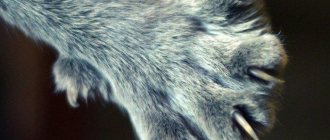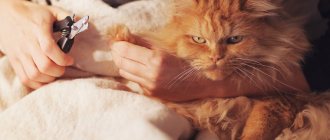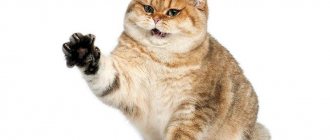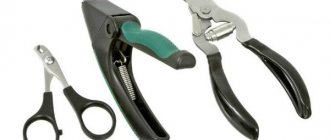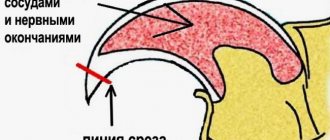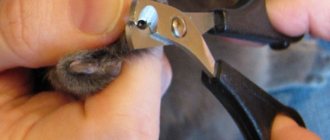Many owners of furry pets wonder why they should trim their cat’s claws at all and how important is this procedure? Any female cat's claws grow throughout her life.
Yard animals independently adjust their length by scratching against the asphalt and tree bark. But it is not easy for domestic cats to do this, so to create the optimal length of their claws, a caring owner and a special tool - a nail clipper - are involved. There are also silicone claw covers for all cat breeds.
If the claws are not trimmed, the consequences can be quite unpleasant, both for the animal itself and for its owner. Too large claws disturb the animal, and there is also a risk of them growing into the pad of the paws, which will cause pain. It will be difficult and quite painful for the cat to move on its paws.
In addition to tormenting the animal, overgrown claws can significantly spoil the appearance of the furniture in the house. The British or British Fold is patient with this procedure, as he has a calm nature by nature, but can fight back. A fluffy kitten, obeying its natural instinct, will definitely find a suitable surface for combing them.
This could be the owner’s favorite sofa, walls with new wallpaper, the door of a stylish cabinet, etc. Do you want to avoid such unpleasant consequences? Then don’t be lazy and regularly trim your beloved pet’s overgrown nails! There is also a special anti-scratch that helps prevent damage to your furniture or you from the animal.
Why do you need to trim your nails?
Claws are horny skin formations that grow throughout life. Under natural conditions, claws are regularly worn down during life. An animal does not need to worry about shortening its nails, as a person does: nature itself does manicures for cats. Those animals that their owners release to frolic in the wild wear off their claws by climbing trees and running on asphalt.
Domestic cats also try to trim their claws on the owner's walls, scratch the door frame and any wooden covering. How many times can you hear the indignation of owners about torn walls, upholstered furniture and numerous traces of cat scratches!
A scratching post allows cats to act in accordance with their instincts, but this does not help much - it’s trite, the cat can ignore the convenient device and enthusiastically continue to tear apart the corner of his favorite sofa. However, the scratching post will not have a significant effect on shortening the cat’s claws.
If you do not help the animal and do not trim the cat's claws, then long claws may grow into the pads of the paws, and the animal will suffer while walking.
Features of the structure of claws
three types of claw growth based on their structure :
- folded like a cat , with curved ends;
- standardly folded , having an arched shape;
- hare type , with straight growth and sharp tips.
The first two options are typical for service and large breeds , and the third type is most often found in decorative dogs.
The structure of the claws has a direct impact on parameters such as posture, as well as balance and grip on the surface during walking and running.
Important! Improper or untimely implementation of the haircut procedure can cause a number of problems, including the appearance of pathologies of the musculoskeletal system, injuries of varying severity, loss of balance or lameness.
All claws in one session, or one paw every day?
Everyone chooses a nail trimming scheme according to their own employment and the level of patience of the animal. How to trim a cat's claws in one fell swoop if she gets nervous and struggles? A short-term procedure in this case is impossible a priori, since everything may end with more or less neatly trimmed claws, but an unpleasant side effect can manifest itself in the form of irritation of the owner and severe fright of the animal.
After treating the claws, you need to praise the cat for its endurance
More humane, although it takes much longer, would be to repeat the procedure every day - it takes much less of the owner’s nerves per paw, and the cat will get used to the procedure in 4 days and will behave much calmer.
After treating the claws, you need to spend some time with your pet, praise him for his endurance (animals understand this very well), play with him, and treat him with a treat. This way, the animal will not develop a final and irrevocable aversion to trimming its claws - it will be interested in the process being completed as quickly and efficiently as possible, because it is followed by a reward.
If you notice blood on a claw, you should not panic
Cat Nail Trimming Tools
Before telling you what tools are used to trim a cat’s claws, it is worth warning that they are not used under any circumstances: ordinary scissors are not suitable, however, neither is the housewife’s favorite manicure set. As an exception, sometimes only a nail file is used for polishing nails.
Specialized pet stores are not uncommon, as are veterinary pharmacies, so you can safely purchase a variety of cat care supplies there. In such places they will always advise and select convenient tools and even give advice on how to trim a cat’s claws .
What is used for cat manicure:
- a nail clipper, which must be sharp. Dull blades often hit sensitive areas and cause pain. Nail clippers are divided into sickle and guillotine clippers;
- a blood stopper or antiseptic. These medications may come in handy if you hit a sensitive part. Iodine or hydrogen peroxide work great. After cauterization, the wound is sprinkled with baby talcum powder;
- blisters - special scissors that look like manicure scissors, but are designed to resemble a cat’s claw;
- file for polishing;
- Long-haired cat breeds, such as Persians, will need a hair clipper, as fur on the paws interferes with the claw trimming process. If the cat is shy or the sound of the running machine irritates him, then the fur from the paws is cut off by hand using scissors;
- alcohol to disinfect accessories. All nail trimming tools must be sanitized before the procedure begins.
Tools
Ordinary nail scissors are not suitable for this procedure for several reasons - the shape does not match, they are poorly sharpened. Special scissors for cats are called nail clippers. They follow the shape of a claw, with a sharp blade, which reduces the risk of injury and increases the speed and efficiency of the procedure.
Even more modern devices are tweezers. They are even more convenient to use. And if you know how to use them, injuries are reduced to a minimum.
If you urgently need to trim your pet’s nails, but don’t have time to buy tools, you can use nail clippers from your own set. However, the material must be of high quality and the base must be well sharpened.
Cat nail trimming tools should be of high quality. Otherwise, they may break themselves, damage the claw plate, and delamination will begin.
In addition, you will need hydrogen peroxide, for cases when bleeding, or another antiseptic. And also cotton wool.
Possible complications after cutting nails
In addition to cutting tools, it is advisable to have some medications with you: hydrogen peroxide, iodine and baby powder.
An inexperienced owner can injure his paw, this is unpleasant, but there is no need to panic. If blood bleeds while grooming a cat, you should fill the wound with peroxide and calm the patient down. The bleeding stops in a short time.
After this, you can sprinkle the damaged area with talc or zinc oxide powder.
Before each use, treat scissors and nippers with an antiseptic solution.
How to choose the right tool
There are times when owners, due to inexperience or ignorance, try to trim their dog’s nails with ordinary household scissors. Should not be doing that! Such “cutters” are simply not designed for such cases. Moreover, such pruning can lead to splitting of your pet’s claw.
For dogs in the trade there is a huge selection of nail clippers of 2 rod types:
- guillotine;
- with a sickle-shaped blade.
A tool with a sickle-shaped blade is used for strong nails of large breeds of dogs. They have two meandering blades and a limiter. A nail cutter with a limiter adjusts the opening of the blades to the size of the claw, which is very convenient.
A guillotine-type nail clipper is intended for small and medium-sized dogs. Their structure provides a ring into which you must first insert the claw, and then carefully trim it. The most convenient way to select a nail clipper is directly at the pet store. Since, in addition to the variety, nail clippers also come in different sizes, you should choose this durable and convenient tool with your dog.
For proper selection, you can trim the tip of your pet’s claw and observe whether it has split. The cut must be smooth and even . This goal is achieved if the item with the required steel quality and sharpness is selected correctly. It is recommended to pay attention to the cutting edges of the blades. They should be free of burrs, and you need to make sure that the blades have no noticeable play. It is extremely important to evaluate the reliability and strength of the handles for holding the nail clipper. It is optimal if they are metal with rubberized gaskets in order to prevent the owner’s fingers from slipping.
How to prepare your cat for the procedure
The owner must know the character of his cat and be able to adapt any procedures to it. This is especially true for nervous or aggressive animals - they may react ambiguously. It’s good if more than one person trims a cat’s claws at home: in such a matter, an assistant will not be superfluous.
A cat that is quite nervous and struggles vigorously should not be forced. In the process of fighting, trimming the claws can injure the paws. You should wait until your cat is in a calm mood before attempting to trim her nails again.
They begin to accustom the animal to any manipulations at the age of a kitten. In any case, the pussy should not be afraid of having its paws touched. Prepare all the tools and wait until your pet is calm.
First, the cat is stroked on its paws and its favorite places. Be sure to stroke every paw. If your pet wants to leave, do not delay her - she must be sure that nothing will be done against her will, and she will calm down.
If your furry pet lets you pet its paws, you need to praise it and treat it with treats. She will get used to such manipulations and will be happy to allow you to touch her limbs.
The cat's paw is placed on the palm and treated with a special treat, which will be given whenever they plan to trim their claws. The paws are massaged one by one with the fingers and at the same time the claws are examined. An animal that trusts its owner will allow pressure on the pads to release its claws.
How to trim a dog's nails
With a nail clipper, you can become proficient in trimming your pet’s nails without nerves and stress for both the owner and the dog. Following the following basic rules will help with this:
- Trimming of nails should begin from the infancy of the pet;
- do not exert pressure or coerce;
- avoid painful sensations;
- choose the moment when your four-legged friend is calm;
- encourage and praise.
It is very important to accustom your dog gradually and slowly to this mandatory procedure. Under no circumstances should this be done forcibly, since the pet’s claws will have to be cut off throughout its entire life. For this reason, it is of great importance that the pet gets used to calmly accepting all manipulations with the nail clipper. First of all, you need to let your pet get acquainted with the nail clipper. To do this, you need to take the dog’s paw, hold it, stroke it, and move it along the claws with a tool.
Slowly increase the amount of time you hold your pet's paw in your hand. Be sure to praise and give a treat upon completion of the procedure.
The same actions are carried out with each paw several times a day. If the dog gets excited and breaks away from your hands, then you should immediately interrupt the lesson. After some time, you need to repeat the manipulation . It makes sense to reduce the time you hold the paw in your hand . Your pet should be rewarded for correct and peaceful behavior. This procedure should not raise negative emotions. It is very important to teach your four-legged friend to allow his paw to be fixed for more than 1 minute without conflict.
Having achieved this, you should proceed to the next step. This stage of training must begin with trimming only one claw, and another time - trim another one. You should not treat all claws at once. After some time, this will be possible, but the main thing is to teach your pet to treat manipulations with the nail clipper without conflict.
What not to do
It is also important to consider that some manipulations can be harmful to the health of the pet.
Do not do it:
- Place the cutting tool parallel to the nail plate, as this can lead to delamination.
- Skip the next manicure session.
- Trim an animal's claws if it is nervous, breaks out, or is aggressive. In such a situation, you can accidentally hurt or injure your pet.
- When pruning, do not touch the pulp, because bleeding and subsequent improper treatment can cause an inflammatory process.
- Carry out the procedure with blunt instruments. This is fraught with problems in the form of delamination or breaking of the claw.
- Plan several different activities related to pet hygiene for one day. This can negatively affect the cat's psychological health.
Nail clipper for dogs: selection criteria and rules of use
When a dog is cramped in an apartment or spends a lot of time in a pen with a wooden covering, rushes along paths with pliable soil, or sits in the arms of the owner, the owner should carefully monitor the pet’s paws. It is especially necessary to pay attention to the enlargement of the claws, which grow on your four-legged friend throughout his life. Growing and becoming excessively long, they cause discomfort to the pet and can lead to muscle atrophy and even joint deformation. A pet can get caught in an overgrown claw, which can lead to injury. In other words, a nail clipper is not only a convenient thing, but also simply necessary.
This is interesting: Rutabaga what is it
Basic rules for trimming nails
To trim a cat’s claws without any problems, you need to follow the same scenario, which includes preparing the animal and the procedure itself.
You can entrust a cat's manicure to a specialist, but it is quite possible to trim a cat's claws at home on your own.
- The claws contain a number of nerve endings and blood vessels that form the pulp. It should not be injured, as it immediately begins to bleed and the animal becomes very painful. No more than 2 mm of the stratum corneum is cut off.
- The procedure is scheduled for daytime so that the claws are clearly visible.
- After preparing the animal, they take it on their lap and talk affectionately. The cat hears the owner's voice and is distracted by it.
- Lightly press on the pad of the paw: the claws should appear.
- Using forceps, only the upper part of the stratum corneum is cut off.
- Repeat the same with the hind legs.
- It is better to sand the ends of the cuts with a file and be sure to remember to treat each area with an antiseptic.
- After the manicure, the cat is praised and again treated to treats.
To properly trim a cat’s claws , take into account the condition of the animal: do not touch the animal on an empty stomach or during active pastime. You must be confident in the health of your pet. But when the cat is getting ready for bed, has eaten a hearty meal and looks happy - it’s time.
If it so happens that the family favorite has damaged its claw, but its condition is not recommended for haircuts, leave it alone for a while. Manicure must be done strictly according to the rules!
First aid for injuries
Even experienced owners may experience situations where the pruning procedure becomes stressful. This could be due to a huge number of factors, ranging from a dull instrument to a sharp sound outside the window that frightened the pet.
It is important to remain calm and clearly understand the algorithm of actions in the event of an injury.
Pulp trauma
If the pruning is done too short, there is a high risk of damaging a large number of blood vessels. In this case, heavy bleeding and sharp pain occur;
This is interesting: Pavel Trubiner Biography Personal
It is the owner's job to stop the bleeding and calm the dog. Try to distract your pet. You should not shout at him, because the animal is in severe pain;
Using brilliant green, an alcohol solution of iodine, or other alcohol-containing antiseptics will only increase the pain. Therefore, many breeders prefer to treat open wounds with antiseptic powder.
You might find our article useful: Home veterinary first aid kit for dogs
This is important: If an injury occurs, and the first aid kit does not have the necessary medications, then experts advise stopping the bleeding with the help of flour.
Claw detonation
This situation arises in case of uncertain actions of the owner. Slow squeezing of the nail clipper by the owner in combination with a sharp jerk of the paw at the moment of manipulation can lead to disastrous results.
As a result, the claw becomes caught in the instrument and the skin and soft tissues rupture. The owner should:
- Remember that this is very painful for your four-legged pet. Therefore, he will try to break free and run away;
- The injured limb should be bandaged with gauze or a tourniquet in the metatarsal area; Raise the limb upward to stop bleeding;
- Apply cold to the injured paw. This could be an ice pack, food or fruit from the freezer;
- Open lesions should be treated with lidocaine. In its absence, this drug can be replaced with novocaine;
- If the wound is too large or the gap needs to be stitched, you should immediately seek help from a veterinarian.
This is important: before you remove frozen food from the freezer, place it in a bag and then wrap it in a towel or cloth. This will help avoid hypothermia. Also, you should not hold the cold on the injured limb for long to avoid frostbite.
The owner should remember that if an injury occurs, the dog must be left alone and not continue the nail trimming procedure for a period of 5-10 days.
Necessity of the procedure
This procedure must be carried out, first of all, in order to prevent the claw from growing into the soft tissue of the paw. After some time, it will become painful for your pet to walk. In addition, the wound can become infected and lead to more serious consequences. The claws on the hind legs are also trimmed. They do not grow into the paw pads, but they are quite difficult to grind off on a scratching post . It is necessary to provide regular care for your cat’s claws in the following cases:
- Sedentary lifestyle or illness . If the animal is not very active, then it cannot sharpen its claws on its own.
- Room contents . Pets are unable to properly care for their nails. If a pet has the opportunity to walk outside, then it is able to cope with its problem on its own.
- If you have small children . A child and a cat do not always get along with each other. Often the animal can release its claws. Therefore, it is worth regularly giving your cat a manicure.
How much does it cost to trim nails at the vet?
Nail trimming in a veterinary clinic is a guarantee of a high-quality and safe procedure. Doctors use professional nail clippers with particularly sharp sharpening. A grooming salon can also help with this manipulation.
The average price of a haircut in Russia is about 300 rubles. In some small clinics, claws can be trimmed for 50 rubles, and in large centers the cost of cutting claws reaches 350-500 rubles.
If the pet is aggressive, and the owner cannot restrain it himself, ensuring the safety of the doctor, additional restraint may be required, which is paid for in most veterinary institutions.
How often to trim a cat's claws
Cat manicures are done as needed, namely as soon as the length of the stratum corneum grows. Usually this takes three weeks. If you do this less often, the animal will wean itself off the procedure.
Always trim before exhibition.
It is enough to check the condition of her claws once a week, and an attentive owner will understand when it is time to trim the cat’s claws.
If something goes wrong, the animal may require veterinary attention. Remember that the main conditions for cutting are the cleanliness of the tools and the animal’s trust in you.
If a vessel is hit
If the cat gets nervous while trimming its nails and constantly tries to jerk its paw, a blood vessel may be damaged.
On a note! Having noticed blood on a claw, you should not panic and invent non-existent horrors - up to and including the development of gangrene in the animal.
Nothing like that will happen - the injury is equivalent to a small cut on a person.
If bleeding does not stop, contact your veterinarian
But it is necessary to prevent germs from getting into the wound - to do this, just rinse it with hydrogen peroxide or any alcohol-containing product. If the bleeding does not stop within 40-60 minutes, you should contact your veterinarian.
Correct haircut
The structure of a dog's claw is such that, in addition to the keratinized part, there is a large blood vessel inside the nail. The uniqueness of the vessel is that it grows with the nail. The longer the nails are not cut, the closer the vessel is to the tip of the nail.
You can see the vessel in the dog’s light-colored claws, but in the black claws it is not visible at all. How to cut a dog's nails correctly?
- First, take your pet's paw in your hand so that it is comfortable for both. Move your finger away, but do not squeeze it.
- Trim the claw at an angle of forty-five degrees, from top to bottom to the beginning of the vessel. That is, you need to cut a few millimeters below the vessel.
- Black claws must be cut a millimeter at a time.
Where should you cut your dog's nails? To the place where the tip of the nail stopped peeling, reaching the dark core of the nail.
- When cutting a nail, carefully inspect the cut; if the core of the nail is white, then you can still cut it.
- Trim each claw in this manner, not forgetting the fifth toe.
- After cutting, you can treat the claws with a file or grinder.
- It is better to start cutting the haircut from the front paws.
- During the grooming process, you can reward your dog with some kind of treat. This video shows how to properly trim a dog's nails.
How often should the procedure be performed?
- Sedentary lifestyle or illness. If the animal is not very active, then it cannot sharpen its claws on its own.
- Room contents. Pets are unable to properly care for their nails. If a pet has the opportunity to walk outside, then it is able to cope with its problem on its own.
- If you have small children. A child and a cat do not always get along with each other. Often the animal can release its claws. Therefore, it is worth regularly giving your cat a manicure.
- Wash your hands well and sterilize the instrument.
- Hold your pet firmly and press on the paw pads until the claw appears.
- The device must be directed at right angles to the desired nail (direction from top to bottom).
- If the animal has a light-colored claw, then it needs to be trimmed within 1-2 mm of the pink area. For cats that have pigmentation, trim 1-2 mm from the tip of the nail so as not to damage the capillaries. If the pet has dark claws, they are trimmed in stages to avoid bleeding.
- Trim the claw in one motion.
- Sand the cut area with a nail file and treat with an antiseptic.
You should not keep your cat in an awkward position for a long time, as this can make her nervous. It is important to know that if a capillary was touched during the procedure, then a bandage or cotton wool moistened with hydrogen peroxide must be applied to it. In addition to this remedy, you can use Chlorhexidine. If you cannot stop the bleeding, you should contact your veterinarian. But usually such manipulation, if you have the proper experience, is quick and painless.
Owners of the Persian or Siberian cat breed will need a special hair clipper. These animals have a lot of hair near their paw pads. They prevent safe nail trimming. If your pet is frightened by the noise of the device, you can cut the hair using scissors. After the procedure, you can treat your pet with his favorite treat. Also, the animal must be praised for its exemplary behavior during the procedure.
On average, a domestic cat needs trimming once a month. If a young animal lives in the house, then a haircut should be done once every 2 weeks. At this age, claws grow faster than those of older cats. You should not skip this procedure, as the pet will get used to it very quickly and the owner will have to accustom him to the unpleasant manipulation again. If an animal is to compete in a competition, its claws must also be trimmed. Otherwise, the cat may be excluded from the competition.
Here you should take into account the individual characteristics of each pet, for example, the rate of growth and lifestyle. Active cats grind off some of their claws on their own, but lazy sofa kings do not. Consequently, the latter need manicure procedures more often. Observe your cat and choose the optimal trimming frequency.
The cat's claws are trimmed
The frequency of performing this procedure is strictly individual. The owner of the animal must find out how quickly the cat’s claws grow and create an individual schedule for the procedure. Some cats go through it no more than once a month, others have to go through a haircut 2, and sometimes 3 times a month.
If a cat not only lives at home, but also often walks outside, then, most likely, his claws will have to be trimmed much less often. They will wear off naturally. But not so effective that you can completely abandon the haircut.
The claw has an outer hard shell, under which the pulp is hidden. It contains blood vessels and nerve endings. The pulp occupies most of the claw. It cannot be damaged. The keratinized part is cut off. This is just a few millimeters at the very tip of the nail.
To avoid mistakes, you must first examine your pet’s claws in the light. They are well translucent and thanks to this you can see the border of the pulp of the keratinized tissue. It is along this border that the claws need to be trimmed.
Naturally, before starting the procedure you need to prepare the appropriate tools.
- Special scissors called nail clippers. They are made of durable stainless steel and are specially designed for this purpose.
- Guillotine trimmer. It is better for beginners to use this device. It is very easy to use and completely safe for your pet.
- Hard nail file. You can use a regular nail file from a manicure set.
All instruments must be disinfected before use. No need to boil. It is enough to treat the tools with alcohol.
It would also be useful to prepare cotton pads, hydrogen peroxide and an antiseptic - chlorhexidine. These items will come in handy if the owner touches the pulp.
In addition to the four working claws, with which the cat catches and holds prey, and tramples on its owners (by the way, massage-stomping is another reason to trim your pet’s claws on time - otherwise a pleasant trampling threatens to turn into a painful ordeal), the animal also has a fifth claw, which must be cut off.
Due to anatomical features, namely its location too high on the paw, the fifth claw cannot be sharpened naturally by walking on the ground or asphalt. In addition, it is located on the inside of the animal’s paw, so it cannot be ground off by wood or scratching posts.
The fifth claw is an invisible front of work that must be done before or after trimming the main claws. The main thing is not to forget about its existence, since the grown fifth claw can cause pain to the animal when walking.
Claws should be trimmed as they grow, approximately once every two to three weeks. This procedure should not be skipped, otherwise cats will quickly wean themselves off it and the owner will have to re-accustom the cat to trimming its claws.
An exception may be in cases where the pet is sick or is under stress.
Owners whose cats participate in exhibitions or competitions before such an important event must trim their pet’s claws, otherwise it may be disqualified.
How often should I trim my hair? It all depends on the individual characteristics of the cat. Experts in the field of felinology strongly recommend accustoming a meowing creature to this procedure from the age of a kitten. Then in “adult” life the pet will treat her more calmly.
You can accustom a baby kitten to a haircut after 1 month of life. Let us warn the owners: “Is it possible to trim a cat’s claws at such a young age?” It is possible and necessary! After all, the sooner a pet gets used to using a nail clipper or scissors, the faster and more painless the grooming process will be in adulthood. But it is up to the owner to clearly determine at what age a cat can be declawed through circumcision. And if the cat is too weak by 4 weeks of life, it is better to abandon the procedure for a while.
There is no point in carrying out the procedure earlier than 1 month. Firstly, the claws of newborn kittens are still too tender, unable to cause pain to either the mother cat or a person. Secondly, kittens under 1 month are not yet so active and spend most of their time on a cozy bed, drinking mother's milk and dreaming. Thirdly, the baby can easily damage the blood vessels located in the thickness of the small claw.
If for some reason an adult cat appears in the house, you can accustom it to grooming too. True, with a mature individual it will be a little more difficult (the cat can break out, hide, bite or scratch the owner).
- Take care of hand and instrument hygiene;
- Calm down, talk to the cat quietly and calmly;
- Place the purr in your arms, taking the tool (claw clipper) in your working hand;
- With your free hand, grasp the cat's paw, pressing on the pads of the fingers so that the claws extend to their full length;
- Holding the nail clipper perpendicular to the claw, cut off its curved tip without affecting the blood vessels;
- If necessary, file the claw with a nail file;
- Trim the claws on all the cat's toes;
- If the pulp is injured, treat with hydrogen peroxide;
- Praise your patient friend by giving him a treat.
Step-by-step instruction
Owners often trim claws only on the front paws, forgetting about the need to do this on the hind paws as well. They should be the same length on all limbs. If the owner plans to mate, the sharp tips may injure another animal. It is also necessary to carry out this procedure before exhibitions, other events where the pet will take part, or transportation over long distances. In this case, the haircut schedule must be adjusted.
There are a number of points that must be fulfilled when carrying out these manipulations. If the pet is sick or in a nervous state, it is advisable to postpone the procedure to a later date. There are some tips on how to properly trim a cat's claws:
- the owner must wash his hands;
- treat the animal’s paws with a disinfectant solution or sanitizer;
- process all tools used;
- take the cat in your arms, calm her down, stroke her, carefully and carefully begin the procedure;
- the paw must be held firmly, but gently, without causing pain;
- In order for the cat to release its claws, you need to gently press on the center of the paw pad;
- find the edge by exposing it to the light; in its part, painted pink, there are vessels, nerve endings that should not be damaged;
- trim the free area, leaving a few millimeters from it;
- file the edge so that there are no rough edges.
During the procedure, you can calm your pet by gently talking to it and stroking it. This will relieve stress, and the haircut itself will not form an association with pain or fear. If necessary, you can use the help of other family members. If the ends are too hard and dense, you can use wire cutters.
All instruments had to be sterile. This minimizes the risk of infection if blood vessels are damaged.
If the regrown edge is painted with black pigment, it is better not to trim a little, than to overdo it and damage the tissue with capillaries. With experience, the owner will learn to intuitively understand where to trim the tips of the nails. The first haircut should be carried out under the supervision of a veterinarian or a person with experience in this matter.
Choosing tools
If you ask owners how many claws a cat has, many will answer that there are 20. This is a misconception; in fact, there are 18. There are five on the front paws, and 4 on the back paws. The procedure itself requires certain tools. The main ones are:
- Special scissors for trimming cat claws or nail clippers. They are similar in shape to manicure ones, but are made of stronger steel and have a special recess located on the inside. Trimming a cat's claws at home with scissors requires skill; a beginner will not be able to cope with this task.
- Wire cutters. They resemble garden pruners, only much smaller. This tool is better suited for large animals. Cat nail trimmers must be of good quality and well sharpened.
- Claw clipper for cats in the form of a guillotine. Its working part has a special hole in which the animal’s claw is placed, and cutting occurs when the handles are compressed. Thus, such a tool with a limiter is convenient to use.
- Cat claw sharpener. After cutting, it is worth treating the claws to remove roughness. This is the very last stage of a manicure or pedicure. You can use an electric grinder instead if your pet is not afraid of buzzing.
Many owners are interested in whether regular scissors can be used to trim a cat's claws. It is possible, but you need sufficient experience and dexterity, since with such a tool there is a higher probability of causing pain and injury to the animal. Manicure or stationery scissors are not suitable for this as they are more likely to lead to splitting of the regrown tip and cause inconvenience to the pet.
What to do when an animal is not given
The cat is not given if the procedure is associated with pain and stress. Perhaps the animal is simply not accustomed. To the question at what age can a kitten’s claws be trimmed, there is a clear answer – from a very early age, in order to quickly form a habit in it.
Gradually you need to accustom the animal with affection and care. During the procedure itself, you should not put pressure on your pet; you should distract him with your voice, and massage his paws just before the manicure. If necessary, you should ask other family members for help.
It is best to seek help from a veterinarian's office. The cost of the service depends on the city of residence, the level of the specialist performing the procedure, and the reputation of the clinic. The price ranges from 400 rubles to several thousand.
Worth reading: Exotic cat breed.
How to trim a small kitten's claws
Kittens develop sharp claws around the first month of life. It is not recommended to cut them at this age, as this can lead to incorrect formation of the plate and its deformation. The first care for them should begin at the age of 5-7 months.
At this age, the kitten tolerates the first haircut with interest and quickly gets used to the process, perceiving this manipulation as a common thing.
What you need to trim nails
To cut cat claws, you need to choose the tool that is most convenient for you, so that it removes excess quickly and painlessly for your pet. You can buy several types of tools to understand exactly which one you intend to use in the future. Since the cat has as many as 18 toes, you can try each type in action.
There are several variations of devices:
- Nail Scissors – The scissors you use to trim your nails should only be used on your teenage kitten's delicate claws. For an adult cat, it is better to have a separate tool, designed taking into account the anatomy of the claw structure.
- Manicure tongs are convenient for removing the tips of claws.
- Blister nail clipper (specialized scissors designed for cats) is an affordable tool that is easy to use.
- Guillon trimmer - this tool can cope with thick claws of the hind paws, the disadvantage of using it is that it is difficult to see which part of the claw will be cut off.
You can choose what is more convenient for you to work with, however, it is preferable to use a blister or guillotine trimmer, because these tools are specially selected for a thick cat's claw.
Additionally, for comfortable nail trimming you may need:
- a piece of cotton wool or a cotton pad;
- hydrogen peroxide;
- hard manicure file;
- a machine for cutting hair (if the cat is too fluffy, this will help remove the hair between the fingers).
Anatomy of a dog's claws
Before you start trimming nails, you need to know the structure of a dog's nail.
A dog's claw has one of the following shapes:
- Curved, cat-like, with a sharp edge.
- Arched, slightly curved inward.
- Straight or hare.
Straight claws are usually characteristic of small toy dogs.
But, regardless of the shape of the claw, its internal structure is the same in all dogs:
- The outer shell is called the keratin sheath and is the visible part of the claw. The keratin sheath is constantly growing and it is this that needs to be trimmed.
- The inner part is the claw bed. A blood vessel passes through the bed, so you need to cut the ends very carefully so as not to touch the blood vessel and nerve endings.
The blood vessel becomes longer or shorter depending on how often the claws are cut: the more often, the deeper the vessel goes. Subsequent haircutting procedures are much easier and safer.
Normally, a dog's claw should not touch the floor by about 2-8 mm . Anything longer causes discomfort for the pet and can cause various diseases of the claws or joints.
If the dog is light-colored, then the claw will most often be light-colored and the blood vessel can be seen. In this case, pruning is convenient and safe - the cut border is immediately visible. If the claw is dark and the blood vessel is not visible, you need to trim it carefully and a little at a time so as not to damage the very sensitive tissue and cause bleeding.
Why does a cat bite its nails?
Sometimes you can witness how cats, like people, bite their nails. Often such actions are perceived as an element of self-care - the cat thus gets rid of the old stratum corneum - the so-called “case”. Or the nail has grown so much that it already causes discomfort and the cat gnaws it. Usually, the listed problems are easily solved by the cat on its own, by grinding its claws on furniture or other surfaces in the house. However, this may not be enough for pets. Here you will need the owner's help to trim your nails. There are also other, more serious reasons for this behavior in cats.
Paying attention to your pet's behavior is the key to its health
The first reason is being in a stressful situation. There can be many reasons for stress in an animal. This includes the appearance of a stranger in the house, a change in the usual environment, be it a move or a trip, and any violent actions towards the cat. At the same time, the animal may not understand the true meaning of actions directed towards it. These types of actions include: taking medications, washing the cat, treating wounds and other similar procedures. The point of these manipulations is to take care of the health of your four-legged pet.
Pets with free access to the street are no strangers to stressful situations - attacks from stray dogs, the chance of getting run over by a car, and simply the possibility of being harmed by people who can harm the animal. If you have not previously observed a cat biting its nails, you should analyze what possible events preceded this.
How to choose the right tool
There are times when owners, due to inexperience or ignorance, try to trim their dog’s nails with ordinary household scissors. Should not be doing that! Such “cutters” are simply not designed for such cases. Moreover, such pruning can lead to splitting of your pet’s claw.
For dogs in the trade there is a huge selection of nail clippers of 2 rod types:
- guillotine;
- with a sickle-shaped blade.
A tool with a sickle-shaped blade is used for strong nails of large breeds of dogs.
They have two meandering blades and a limiter. A nail cutter with a limiter adjusts the opening of the blades to the size of the claw, which is very convenient. A guillotine-type nail clipper is intended for small and medium-sized dogs. Their structure provides a ring into which you must first insert the claw, and then carefully trim it. The most convenient way to select a nail clipper is directly at the pet store. Since, in addition to the variety, nail clippers also come in different sizes, you should choose this durable and convenient tool with your dog.
For proper selection, you can trim the tip of your pet’s claw and observe whether it has split. The cut must be smooth and even. This goal is achieved if the item with the required steel quality and sharpness is selected correctly. It is recommended to pay attention to the cutting edges of the blades. They should be free of burrs, and you need to make sure that the blades have no noticeable play. It is extremely important to evaluate the reliability and strength of the handles for holding the nail clipper. It is optimal if they are metal with rubberized gaskets in order to prevent the owner’s fingers from slipping.
What to do if your cat resists
If your cat won’t let you cut her nails, you can try to accustom her to this procedure gradually, the main thing is to be patient.
Try a few simple tricks:
- If your cat doesn’t have enough patience for a long time, start small. To begin with: cut two claws and release the pet, not forgetting to praise. Then cut off more, and increase the number of toes until you have processed all the paws.
- Wait until the cat has no desire to resist when she has eaten and becomes sleepy.
- Try trimming nails while your cat is sleeping.
- If your cat becomes stressed due to the procedure, you can try giving him sedatives using natural herbs, for example, “Cat Bayun”.
- If you catch a kitten in a playful mood, you should postpone claw trimming until the kitten becomes less agitated.
We hope that our article will help you develop an effective strategy for trimming your pet's nails. If your cat won’t let you get close to his manicure with scissors or has an aggressive character, then we recommend reading our article about silicone anti-scratch pads (harmless to the pet’s body and a solution for responsible owners). Share with us and our readers in the comments: what tricks do you practice when trimming your cats’ claws?
How to trim a dog's nails
With a nail clipper, you can become proficient in trimming your pet’s nails without nerves and stress for both the owner and the dog. Following the following basic rules will help with this:
- Trimming of nails should begin from the infancy of the pet;
- do not exert pressure or coerce;
- avoid painful sensations;
- choose the moment when your four-legged friend is calm;
- encourage and praise.
It is very important to accustom your dog gradually and slowly to this mandatory procedure. Under no circumstances should this be done forcibly, since the pet’s claws will have to be cut off throughout its entire life. For this reason, it is of great importance that the pet gets used to calmly accepting all manipulations with the nail clipper. First of all, you need to let your pet get acquainted with the nail clipper. To do this, you need to take the dog’s paw, hold it, stroke it, and move it along the claws with a tool.
Slowly increase the amount of time you hold your pet's paw in your hand. Be sure to praise and give a treat upon completion of the procedure.
The same actions are carried out with each paw several times a day. If the dog gets excited and breaks away from your hands, then you should immediately interrupt the lesson. After some time, you need to repeat the manipulation. It makes sense to reduce the time you hold the paw in your hand. Your pet should be rewarded for correct and peaceful behavior. This procedure should not raise negative emotions. It is very important to teach your four-legged friend to allow his paw to be fixed for more than 1 minute without conflict.
Having achieved this, you should proceed to the next step. This stage of training must begin with trimming only one claw, and another time - trim another one. You should not treat all claws at once. After some time, this will be possible, but the main thing is to teach your pet to treat manipulations with the nail clipper without conflict.
